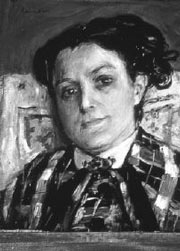FROM COROT TO PICASSO
Seattle Art Museum, 100 University, 654-3100, $10 10 a.m.-5 p.m. Tues.-Sun.; 10 a.m.-9 p.m. Thurs. ends Sun., Sept. 15
IN THE 19TH century, the word “painting” came to be a near synonym for “French painting,” and works created during the period still form the core of many great museum collections. The holdings of the Smith College Museum of Art are puny in bulk compared to those of the Mus饠d’Orsay or the Metropolitan, but disproportionately powerful thanks to 80-odd years of intelligent and focused collecting.
Displaced by remodeling from their home quarters in Northampton, Mass., 50 paintings from the Smith collection are spending the summer in Seattle. Such distinguished visitors would be welcome at any time, but given the dearth of 19th- century painting of any kind locally, “From Corot to Picasso” is like a rain shower in a season of drought.
Ad hoc touring shows of this kind—take-it-or-leave-it assemblies dictated more by circumstance than curatorial initiative—are often a mixed blessing. But the man who started the European collection at Smith, Alfred Vance Churchill, realized that, given the college’s limited financial resources, only a narrowly focused purchasing policy could produce distinguished results.
In an astonishingly farsighted manifesto, Churchill wrote in 1919: “Everything in the collection must show the imaginative conception of the master who made it. . . . [I]t must be ‘signed all over’ with the characters that he and he alone has given the world or could give.” In pursuit of that goal, “I was willing to acquire a fragment . . . for even a fragment may reveal the master. I would take an unfinished work . . . for such a work may convey quite as much as a finished one.”
Churchill’s successors maintained his focus. Jere Abbott, who came to the directorship in 1933, was primarily interested in the art of his own time; one of his first purchases was the stunning Picasso abstraction of 1919, Table, Guitar, and Bottle. But he had an eye for treasures of older masters, too: It was he who purchased the tiny exquisite study for Seurat’s gigantic Sunday Afternoon on the Island of La Grande Jatte.
Another early Abbot acquisition shows extraordinary insight. Edgar Degas was 25 when he began The Daughter of Jephthah in 1859, just back from three years of saturation in the masterworks of Renaissance Italy. In choosing a biblical subject for a huge epic narrative painting, Degas was following the conventions of an earlier generation of painters. But despite poses and groupings derived from 15th-century originals, the figures in Degas’ composition are already trapped in that forward-tipped perspective and space-bending depth of field which we see in his balcony-eye view of ballet scenes painted 20 years later.
In Jephthah, the tension between musty subject and contemporary treatment almost makes your eyes cross. (Degas may have felt that way himself; he never finished the piece.) But other early Abbot purchases offer the same kind of tension in a more accessible form. J.B.C. Corot (1796-1875) is best known for his landscapes, in which he laid the foundations for the later Impressionists’ airy way with light and shade. One such work is on view here but overshadowed by another: a rare Corot portrait, only about a foot square but portraying a blonde girl as massively present as a mountain.
Other works offering the double payoff of initial surprise and mature appreciation are an early Gauguin, an urban landscape looking almost fussy in the light of the painter’s later slathery approach to paint and composition, and, conversely, a middle-period oil sketch by C麡nne blessedly free of that artist’s compulsive dabbing at a canvas until no air can possibly penetrate its lovely, dry surface. There’s a Manet portrait, too, so loose and informal in handling that one would never guess the same hand painted the utterly controlled and formal Olympia or Luncheon on the Grass.
One of the most intriguing images in the show is Puvis de Chavannes’ The Poor Fisherman, dating from about 1880. A ragged figure stands in a tiny rowboat looking out over a viscous pea-soup sea, his back turned on the barefoot woman and naked baby gathering flowers on the shore. Delicately balanced between realism and symbolism, Puvis’ family group snaps into sharper focus when juxtaposed (as in this exhibition) with Picasso’s 1903 Figures by the Sea. Here, again, is a tatteredemalion family by the shore, but this one moves together and purposefully toward a goal beyond the frame. If Puvis is showing us the human family exiled from paradise, Picasso, for all his surface Blue Period gloom, offers something more like the holy family fleeing into Egypt, poor and driven but looking forward.
Perhaps the most powerful work in the whole show, though, offers nothing so dramatic. It’s a tiny (again, barely a foot square) portrait of a lady by Renoir but far in spirit and execution from his later blowsy, fruit-salad women. Madame Mae is skeptical, wide-awake, manifestly intelligent; it’s hard to believe that the hand which shaped the planes of her face, not to mention the rough, confident geometric brushwork of her dress, could ever have descended to Technicolor mush. But that’s what makes this show so satisfying; almost every work provides a jolt of the new while satisfying our craving for something old and beautiful.









